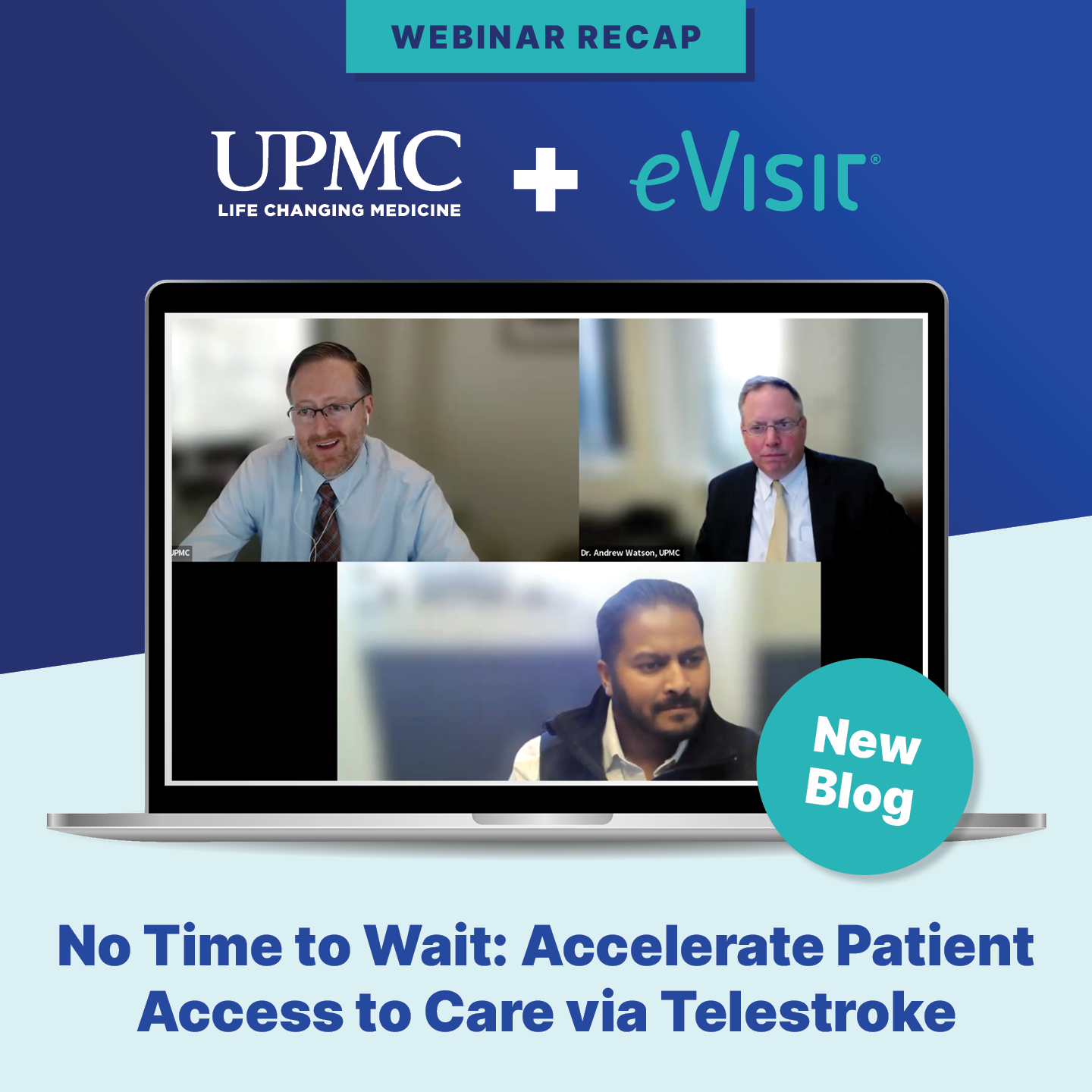UPMC is a world-renowned, nonprofit healthcare provider and insurer headquartered in Pittsburgh and is one of the 20 largest health systems in the country. With a network of over 40 hospitals and 800 outpatient sites across Pennsylvania, Maryland, New York, and internationally, UPMC is committed to advancing community well-being through people-centered care delivery, clinical and technological innovation, research, and education.
UPMC has been at the forefront of telestroke technology for the past two decades, enabling neurologists to evaluate and treat stroke patients remotely. Their telestroke program provides 24/7 access to specialized neurology and stroke care expertise, delivering life-saving interventions for patients who may otherwise face significant barriers to timely care. Earlier this year, eVisit acquired UPMC’s inpatient teleconsult technology, facilitating over 40,000 expert consults across five critical inpatient services to date, reducing wait times by 92%.
As part of our Virtually Integrated Care webinar series, we heard from Dr. Andrew Watson (Sr. Medical Director, UPMC Health Plan, Sr. Medical Advisor, UPMC Enterprises, Past-President, American Telemedicine Association) and Dr. Matthew Starr (Vascular Neurologist and Associate Director of the UPMC Stroke Institute, Director of the Comprehensive Stroke Centers at UPMC Presbyterian and UPMC Mercy, Assistant Professor of Neurology at the University of Pittsburgh School of Medicine). They shared insights on how to start, grow, and scale a telestroke program, and discussed the latest developments in UPMC and eVisit’s collaboration to enhance inpatient care across stroke, neurology, critical care, psychology, and toxicology. The full webinar is available for download here.
The 8 Ds of Stroke Care
Every 40 seconds, someone in the U.S. has a stroke, leading to over 140,000 deaths annually and many more facing long-term disability due to delayed or inappropriate treatment. This is especially challenging in rural areas, where experienced stroke care teams may be hours away.
Dr. Starr highlighted the “8 D’s of Stroke Care,” critical measures for timely acute stroke management. Each step, from initial detection to final disposition, reinforces the idea that ‘time is brain’—with each minute during a stroke resulting in the loss of 1.9 million neurons.
Here’s a quick breakdown of the 8 D’s:
- Detection – Recognizing stroke symptoms early.
- Dispatch – Calling 911 to initiate emergency response.
- Delivery – Transporting to the right stroke-capable hospital.
- Door – Speedy entry and triage in the ER.
- Data – Gathering and evaluating critical imaging and labs.
- Decision – Deciding on interventions, like IV thrombolytics.
- Drug – Administering appropriate medication.
- Disposition – Deciding on the most appropriate level of care post-treatment.
Dr. Starr emphasized the vital role of telestroke teams, particularly in the Data and Decision phases, where fast, accurate care decisions can significantly improve patient outcomes.
“The faster we treat with lytic, the better patients do,” Starr noted. “We work with our sites to standardize protocols to really shave seconds and minutes off. We want to save those neurons.”
By streamlining protocols to bring patients into active care within moments of arrival, UPMC’s telestroke program is shaving critical minutes from the intervention timeline. The telestroke team stands ready to jump in within minutes of being notified, ensuring rapid imaging interpretation, consultation, and treatment decisions.
Role of Telehealth in Stroke Workflows
Standardized clinical workflows and effective coordination between bedside and telestroke providers can significantly impact outcomes, particularly for patients eligible to receive vascular interventions.
Upon patient arrival, the triage team quickly identifies stroke symptoms and initiates a series of parallel actions. While the patient undergoes imaging, the bedside provider notifies the on-call telestroke provider using eVisit’s platform and receives a quick callback—often within just 35 seconds. The team reviews essential patient history, including last seen well times and any contraindications for treatment. They are prepared to evaluate the patient via video conferencing and integrated Point Tilt Zoom (PTZ) cameras once they return from imaging. Meanwhile, the ER team prepares the thrombolytic therapy.
“The standardization of how to communicate with us, how to see us on video, how we can review the imaging and data. That’s really been the biggest bang for the buck in terms of improving the quality of our care here,” Dr. Starr noted, highlighting the benefits of streamlined workflows and the removal of complex call-center routing for consults.
He emphasized the significance of telestroke in enhancing access to critical acute stroke treatment and highlighted research indicating that telestroke can help reduce geographic, gender, and racial disparities in stroke treatment. Dr. Starr stated, “With telestroke, we’re really bringing the expert specialty care to wherever the patient is.”
Addressing Access Barriers and Enhancing Quality of Life
Dr. Watson and Dr. Starr shared how telehealth can integrate seamlessly into various aspects of care delivery and mitigate patient quality-of-life challenges.
Dr. Watson noted how insights from the telestroke networks developed by Dr. Starr and others are being applied across other subspecialties, expanding into consult centers and broader areas of telemedicine. He discusses how telehealth “takes healthcare back to the patients” by providing immediate access to appropriate care, and offering a safer and more comfortable option in many cases.
Dr. Watson emphasized how telehealth effectively mitigates unique access challenges faced by patients in both rural and underserved urban areas, such as long commutes, difficult driving conditions, extreme weather, and high asthma rates. He also highlighted that provider satisfaction also improves when they can conduct meaningful, high-quality consults remotely. “The outcomes have shown that telestroke is extremely effective no matter where the provider is,” he stated.
Both Dr. Watson and Dr. Starr both emphasized the financial and emotional benefits of keeping stroke patients at their local centers. Dr. Starr highlighted ongoing efforts to decrease unnecessary transfers through standardized protocols and teleneurology rounding. These alleviate strain on transfer centers and main hubs and allow patients to remain close to their families and communities during treatment.
The financial impact of telehealth is significant, with patients saving an average of $167 in driving expenses for every outpatient visit. Since its inception a year and a half ago, UPMC’s virtual-first surgery program led by Dr. Watson has saved 120,000 miles of driving, 2,164 patient hours, $70,000 in patient expenses, and reduced carbon dioxide emissions by 47,000 kilograms. By continuing to expand telehealth capabilities and initiatives, UPMC is at the forefront of implementing innovative solutions that enhance care delivery and foster healthier, more connected communities.
Ensuring Reliability and Trust in Telehealth Delivery
Dr. Watson shared how the groundwork laid by telestroke pioneers like Dr. Starr and his team not only demonstrates the life-saving potential for stroke care but also educates communities about the effectiveness and safety of virtually integrated care. He emphasizes that reliable systems are essential in telehealth delivery to provide consistent, high-quality care when and where it’s needed most.
“The stroke process has taught us that has to work. It can’t fail.”
Dr. Watson explained that this reliability hinges on standard operating procedures and thoughtful service-oriented architecture in design. The success and visibility of telestroke “really helps to promote that is safe care, it’s good care, it’s life-saving care” to broader communities, even for urgent and emergent issues.
Dr. Watson stated that the ‘tele’ part of telemedicine should ideally disappear into the background. He likened effectively integrated technology to intuitively riding a bike:
“You don’t look down at the tires the spokes. You don’t think about the gear shifter the handlebars. When you ride, it just works.”
Dr. Watson discussed the focus of making the technology that powers telehealth, such as the eVisit platform, function seamlessly so that healthcare providers can focus entirely on their patients without distractions from IT issues.
“You can’t be focused on audiovisual controls or lags in the middle of an urgent situation. We’ve really come to expect the best in technology. It’s very important to us because without that, you can get distracted. If it’s an emergent situation or if you’re really troubleshooting a difficult situation, it can be very distracting,” Dr. Watson stated.
Seamlessly integrating and scaling virtual-first clinical care delivery requires a reliable technology partner, not makeshift solutions. We’re honored to partner with UPMC Enterprises to expand these efforts and enable efficient, world-class clinical care delivery that is seamless for both patients and providers.
Telestroke Staffing and Resource Consolidation Strategies
Dr. Watson and Dr. Starr discussed strategies that enable healthcare organizations to consolidate resources and deliver care more effectively across multiple locations.
Dr. Starr explained how the telestroke network enhances ROI by maximizing provider capacity, allowing them to deliver neurology and stroke care across diverse settings and meeting a broader range of patient needs. He emphasized that employing a telestroke group is generally less expensive than hiring multiple stroke providers to live in rural areas, which is often impractical.
He also shared creative staffing strategies, such as hiring stroke neurohospitalist hybrid positions to alleviate some of the call burden on telestroke teams. Some of the sites taken over for coverage had neurologists who were not stroke-trained and were reluctant to be on call. By offloading telestroke coverage to their group, these communities retained valuable outpatient neurology expertise. This approach not only reduced turnover costs but also kept general neurology practices operational in smaller communities.
Dr. Watson noted that similar principles apply across different specialties, highlighting that most medicine is practiced in community hospitals. In these settings, effective communication and positive experiences lead to word-of-mouth recommendations about the network’s high quality and value. Building strong relationships and supporting knowledge transfer among organizations and providers is crucial for implementing and scaling high-performing and integrated telehealth solutions.
Curious to hear how other leading health systems are transforming digital care across the enterprise? Our full webinar series can be accessed here or check out these webinar recap blogs below:





